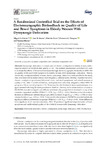A Randomized Controlled Trial on the Effects of Electromyographic Biofeedback on Quality of Life and Bowel Symptoms in Elderly Women With Dyssynergic Defecation

Ver/Abrir
Use este enlace para citar
http://hdl.handle.net/2183/25224Colecciones
- Investigación (FEDU) [938]
Metadatos
Mostrar el registro completo del ítemTítulo
A Randomized Controlled Trial on the Effects of Electromyographic Biofeedback on Quality of Life and Bowel Symptoms in Elderly Women With Dyssynergic DefecationFecha
2019Cita bibliográfica
Simón MA, Bueno AM, Otero P, Vázquez FL, Blanco V. A Randomized Controlled Trial on the Effects of Electromyographic Biofeedback on Quality of Life and Bowel Symptoms in Elderly Women With Dyssynergic Defecation. International Journal of Environmental Research and Public Health. 2019; 16(18):3247.
Resumen
[Abstract] Dyssynergic defecation is a usual cause of chronic constipation in elderly women, with a negative impact on health-related quality of life. The present randomized controlled trial aims to evaluate the effects of behavioral treatment through electromyographic biofeedback (EMG-BF) on quality of life and bowel symptoms in elderly women with dyssynergic defecation. Twenty chronically constipated elderly women, due to dyssynergic defecation, were enrolled in the study. Outcome measures included weekly stool frequency, anismus index, severity of patient-reported chronic constipation symptoms (abdominal, rectal, and stool symptoms), and overall measure of quality of life. After 1 month of baseline, participants were randomly assigned to either EMG-BF group (n = 10) or control group (n = 10). Three months after treatment, female patients were once again assessed following the same procedure in baseline. One-way multivariate analysis of variance MANOVA revealed no significant differences between the groups before treatment in any of the measured dependent variables (Wilks’s λ = 0.74; F6,13 = 0.77; p = 0.61). Likewise, univariate analysis showed no differences between the groups, either in terms of age (F1,18 = 0.96; p = 0.34) or mean disease duration (F1,18 = 2.99; p = 0.11). Three months after treatment, MANOVA revealed statistically significant differences between the groups (Wilks’s λ = 0.29; F6,13 = 5.19; p < 0.01). These differences were significant in all outcome measures. EMG-BF produces significant improvements in bowel symptoms and health-related quality of life of elderly women with dyssynergic defecation.
Palabras clave
Behavioral treatment
Chronic constipation
Dyssynergic defecation
EMG-biofeedback
Chronic constipation
Dyssynergic defecation
EMG-biofeedback
Versión del editor
Derechos
Atribución 3.0 España






